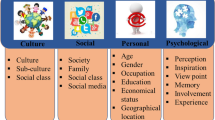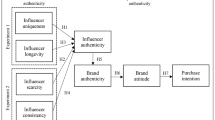Abstract
The article expands on the current brand equity literature by recommending new assets and liabilities unique to brands that are bounded to their origins (OBBs). These are brands that are inseparable from their origins, as is the case with most wines. A review of both the origin and branding literature is undertaken and a conceptual approach is used to propose the different ways that OBBs may build brand equity. Brand assets specific to OBBs are detailed, such as tolerance for inconsistencies, authenticity perceptions and origin loyalty. Likewise a specific liability, lack of origin recognition is also examined. Finally, consequences of origin-driven brand equity are outlined and include: encouraged hedonic and ego-political consumption values, limited purchase of counterfeit products and decreased price sensitivity. Before this article, very little conceptual and empirical literature addressed the concept of brands that are bounded to their origin. The article describes possibilities for future research pertaining to this important category of brands, present not only in the wine industry but also common to a variety of other product categories.

Similar content being viewed by others
References
Aaker, D.A. (1991) Managing Brand Equity. New York: The Free Press.
Aaker, D.A. (1996) Building Strong Brands. New York: The Free Press.
Aitken, R. and Campelo, A. (2011) The four Rs of place branding. Journal of Marketing Management 27 (9–10): 913–933.
Alderson, W. and Martin, M.W. (1965) Toward a formal theory of transactions and transvections. Journal of Marketing Research 2 (2): 117–127.
Aurier, P.P. and Fort, F. (2005) Effets de la région d’origine, du produit, de la marque et de leurs congruences, sur l’évaluation des consommateurs: Application aux produits agroalimentaires. Recherche et Applications en Marketing 20 (4): 29–52.
Babin, B.J., Darden, W.R. and Griffin, M. (1994) Work and/or fun: Measuring hedonic and utilitarian shopping value. Journal of Consumer Research 20 (4): 644–656.
Ballantyne, D. (2011) Sustaining the promise of terroir: The case of the Central Otago Wine Region. Paper presented at the 6th Academy of Wine Business Research Conference; June, Bordeaux, France.
Barham, E. (2003) Translating terroir: The global challenge of French AOC labelling. Journal of Rural Studies 19 (1): 127–138.
Becattini, G. and Rullani, E. (1996) Local systems and global connections: The role of knowledge. In: F. Cossentino, F. Pyke and W. Segenberger (eds.) Local and Regional Response to Global Pressure: The Case of Italy and Its Industrial Districts. Geneva, Switzerland: International Institute for Labor Studies.
Belk, R.W. (1988) Possessions and the extended self. Journal of Consumer Research 15 (2): 139–168.
Beverland, M. (2005) Crafting brand authenticity: The case of luxury wines. Journal of Management Studies 42 (5): 1003–1029.
Beverland, M. and Lindgreen, A. (2002) Using country of origin in strategy: The importance of context and strategic action. Journal of Brand Management 10 (2): 147–167.
Beverland, M., Lindgreen, A. and Vink, M.W. (2008) Projecting authenticity through advertising. Journal of Advertising 37 (1): 5–15.
Bird, K. et al. (2009) Ethiopia trademarking and licensing initiative: Supporting a better deal for coffee producers through aid for trade, http://www.odi.org.uk/resources/docs/5946.pdf, accessed 25 April 2012.
Boyle, D. (2003) Authenticity: Brands, Fakes, Spin and the Lust for Real Life. London: HarperCollins.
Bruwer, J. and Johnson, R. (2010) Place-based marketing and regional branding strategy perspectives in the California wine industry. Journal of Consumer Marketing 27 (1): 5–16.
Chakraborty, G., Allred, A.T. and Bristol, T. (1996) Exploring consumers’ evaluations of counterfeits: The roles of country of origin and ethnocentrism. Advances in Consumer Research 23: 379–384.
Chao, P. (2001) The moderating effects of country of assembly, country of parts, and country of design on hybrid product evaluations. Journal of Advertising 30 (4): 67–81.
Charters, S. (2006) Aesthetic products and aesthetic consumption: A review. Consumption, Markets and Culture 9 (3): 235–255.
Charters, S. (2009) Does a brand have to be consistent? Journal of Product and Brand Management 18 (4): 284–291.
Charters, S., Mitchell, R. and Menival, D. (2011) The territorial brand in wine. Paper presented at the 6th Academy of Wine Business Research Conference; June, Bordeaux, France.
Charters, S. et al. (2011) Generation Y and sparkling wines: A cross-cultural perspective. International Journal of Wine Business Research 23 (2): 161–175.
Chernev, A. (2004) Goal-attribute compatibility in consumer choice. Journal of Consumer Psychology 14 (1–2): 141–150.
Cobb-Walgren, C.J., Rubleand, C.A. and Donthu, N. (1995) Brand equity, brand preference and purchase intent. Journal of Advertising 24 (3): 25–40.
Commuri, S. (2009) The impact of counterfeiting on genuine-item consumers’ brand relationships. Journal of Marketing 73 (3): 86–98.
Day, G.S. (2011) Closing the marketing capabilities gap. Journal of Marketing 75 (4): 183–195.
Euromonitor (2012) Cheese in the US: Category briefing, http://www.euromonitor.com, accessed 20 November 2013.
Gabriel, P. and Urien, B. (2006) Valeurs de consommation et origine territoriale des produits. Décisions Marketing 43/44: 41–54.
Gentry, J.W., Putrevu, S., Shultz II C. and Commuri, S. (2001) How now Ralph Lauren? The separation of brand and product in a counterfeit culture. In: M.C. Gilly and J. Meyers-Levy (eds.) Advances in Consumer Research. Vol. 28. Valdosta, GA: Association for Consumer Research, pp. 258–265.
Gibbs, P.T. (1998) Time, temporality and consumer behaviour. European Journal of Marketing 32 (11/12): 993–1007.
Grayson, K. and Martinec, R. (2004) Consumer perceptions of iconicity and indexicality and their influence on assessments of authentic market offerings. Journal of Consumer Research 31 (3): 296–312.
Grayson, K. and Shulman, D. (2000) Indexicality and the verification function of irreplaceable possessions: A semiotic analysis. Journal of Consumer Research 27 (1): 17–30.
Hankinson, G. (2009) Managing destination brands: Establishing a theoretical foundation. Journal of Marketing Management 25 (1–2): 97–115.
Huber, J. and McCann, J. (1982) The impact of inferential beliefs on product evaluations. Journal of Marketing Research 19 (3): 324–333.
Hunt, S.D. and Morgan, R.M. (1995) The comparative advantage theory of competition. Journal of Marketing 59 (2): 1–15.
Johnson, R. and Bruwer, J. (2007) Regional brand image and perceived wine quality: The consumer perspective. International Journal of Wine Business Research 19 (4): 276–297.
Kahney, L. (2004) The Cult of Mac. San Francisco: No Starch Press.
Keller, K.L. (1993) Conceptualizing, measuring, and managing customer-based brand equity. Journal of Marketing 57 (1): 1–22.
Kjeldgaard, D. and Ostberg, J. (2007) Coffee grounds and the global cup: Glocal consumer culture in Scandinavia. Consumption Markets and Culture 10 (2): 175–187.
Kniazeva, M. and Charters, S. (2011) Staging authenticity in the cellars of champagne. Paper presented at the 6th Academy of Wine Business Research Conference; June, Bordeaux, France.
Landon, S. and Smith, C.E. (1997) The use of quality and reputation indicators by consumers: The case of Bordeaux wine. Journal of Consumer Policy 20 (3): 289–323.
Leigh, T.L., Peters, C. and Shelton, J. (2006) The consumer quest of authenticity: The multiplicity of meanings within the MG subculture of consumption. Journal of the Academy of Marketing Science 34 (4): 481–493.
Magnusson, P., Westjohn, S.A. and Zdravkovic, S. (2011) ‘What, I thought Samsung was Japanese’: Accurate or not, perceived country of origin matters. International Marketing Review 28 (5): 454–472.
Obermiller, C. and Spangenberg, E. (1989) Exploring the effects of country-of-origin labels: An information processing framework. In: T.K. Srull (ed.) Advances in Consumer Research. Vol. 16. Provo, Utah: Association for Consumer Research, pp. 454–459.
Perrouty, J., d’Hauteville, F. and Lockshin, L. (2006) The influence of wine attributes on region of origin equity: An analysis of the moderating effect of consumer’s perceived expertise. Agribusiness 22 (3): 323–341.
Pitta, D.A. and Katsanis, L. (1995) Understanding brand equity for successful brand extension. Journal of Consumer Marketing 12 (4): 51–64.
Samiee, S., Shimp, T.A. and Sharma, S. (2005) Brand origin recognition accuracy: Its antecedents and consumers’ cognitive limitations. Journal of International Business Studies 36 (4): 379–397.
Schouten, J.W. and McAlexander, J.H. (1995) Subcultures of consumption: An ethnography of the new bikers. Journal of Consumer Research 22 (1): 43–61.
Spielmann, N. and Babin, B.J. (2011) Testing congruency effects between origin and producer for wines. International Journal of Wine Business Research 23 (4): 338–354.
Stewart, S. (1993) On Longing: Narratives of the Miniature, the Gigantic, the Souvenir, the Collection. Durham, NC: Duke University Press.
Tangari, A.H., Burton, S., Andrews, J.C. and Netemeyer, R.G. (2007) How do antitobacco campaign advertising and smoking status affect beliefs and intentions? Some similarities and differences between adults and adolescents. Journal of Public Policy and Marketing 26 (1): 60–74.
Teuber, R. (2009) Café de Marcala – Honduras’ GI approach to achieving reputation in the coffee market. The Estey Centre Journal of International Law and Trade Policy 10 (1): 131–48.
Thakor, M.V. and Kohli, C.S. (1996) Brand origin: Conceptualization and review. Journal of Consumer Marketing 13 (3): 27–42.
Tseng, T. and Balabanis, G. (2011) Explaining the product-specificity of country-of-origin effects. International Marketing Review 28 (6): 581–600.
Usunier, J. (2011) The shift from manufacturing to brand origin: Suggestions for improving COO relevance. International Marketing Review 28 (5): 486–496.
van Ittersum, K., Meulenberg, M.T.G., van Trijp, H.C.M. and Candel, M.J.J.M. (2002) Certificates of origin and regional product loyalty. In: S.M. Broniarczyk and K. Nakamoto (eds.) Advances in Consumer Research Volume. Vol. 29. Valdosta, GA: Association for Consumer Research, pp. 549–550.
van Ittersum, K., Meulenberg, M.T.G. and van Trijp, H.C.M. (2003) Determinants of the accessibility of regional-product information. In: P.A. Keller and D.W. Rook (eds.) Advances in Consumer Research Volume. Vol. 30. Valdosta, GA: Association for Consumer Research, pp. 180–187.
Author information
Authors and Affiliations
Corresponding author
Additional information
1obtained her PhD from Concordia University (Montreal, Canada) in 2010 and integrated the faculty at Reims Management School that same year. Her research interests include advertising effects, origin effects and consumer behaviour with origin-based (and particularly wine) products. She has published in the European Journal of Marketing, Journal of Business Research, Journal of Services Marketing, International Journal of Wine Business Research and the International Journal of Hospitality Management.
Rights and permissions
About this article
Cite this article
Spielmann, N. Brand equity for origin-bounded brands. J Brand Manag 21, 189–201 (2014). https://doi.org/10.1057/bm.2013.30
Received:
Revised:
Published:
Issue Date:
DOI: https://doi.org/10.1057/bm.2013.30




